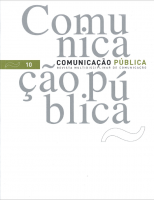Unfreezing ethnicity as culture in public relations
Immigrant image and static categories in an age of liquid fear
DOI:
https://doi.org/10.4000/cp.433Keywords:
race, immigration, liquid society, public relations, culture, Zygmunt BaumanAbstract
The most cited theory in mainstream public relations relevant to ethnicity and race is Geert Hofstede’s concept of culture. In this article, we argue for augmenting Hofstede’s work for three reasons: to go beyond the limitations of his relatively static theorization; to engage with the reality of rapid social movement around ethnicity and race; and to take account of racism. To expand public relations theory around these issues, we work with Zygmunt Bauman’s theorization that fluid boundaries, including swift-shifting emotions, are what characterize contemporary societies. We also deploy Bauman’s ideas in the context of media representations of relations with immigrants in Catalonia. In particular, we explore how these representations may help public relations not only to identify, but to realize, its symbolic power in reducing fear and tension by improving relations between dominant, or host, cultures and their ethnically different minorities.
Downloads
References
Akerlof, G. A., & Shiller, R. J. (2009). Animal spirits: How human psychology drives the economy, and why it matters for global capitalism. Princeton, NJ: Princeton University Press.
Balibar, E., & Wallerstein, I. (1988). Race, nation, classe. Paris: La Découverte.
Banks, S. (2000). Multicultural public relations: A social-interpretive approach (2nd. ed.). Ames, IA: Iowa State University Press.
Bauman, Z. (1992). Soil, blood and identity. Sociological Review, 40(4), 675–701.
Bauman, Z. (1995). Life in fragments: Essays in postmodern morality. Oxford: Blackwell
Bauman, Z. (2000). Liquid modernity. Cambridge: Polity Press.
Bauman, Z. (2003). Liquid love: On the frailty of human bonds. Cambridge: Polity Press.
Bauman, Z. (2004). Wasted lives: Modernity and its outcasts. Cambridge: Polity Press.
Bauman, Z. (2005). Liquid life. Cambridge: Polity Press.
Bauman, Z. (2006). Liquid fear. Cambridge: Polity Press.
Bauman, Z. (2007a). Liquid times: Living in an age of uncertainty. Cambridge: Polity Press.
Bauman, Z. (2007b). Consuming life. Cambridge: Polity Press.
Bauman, Z. (2007c). Collateral casualties of consumerism. Journal of Consumer Culture, 7(1), 25-56.
Bauman, Z. (2008). Liquid fear. Presentation to the World Social Summit, Rome, September, 2008. http://www2.worldsocialsummit.org Retrieved 01.10.08.
Bauman, Z. (2009). Confianza y temor en la ciudad. Vivir con extranjeros. Barcelona: Arcadia.
Bentele, G., & Wehmeier, S. (2007). Applying sociology to public relations: A commentary. Public Relations Review, 33(3), 294-300.
Edwards, L. (2006). Rethinking power in public relations. Public Relations Review, 36(3), 229-231.
Edwards, L. (2010). “Race” in public relations. In R. Heath (Ed.), SAGE Handbook of public relations (2nd. ed.) (pp. 205-221). Thousand Oaks, CA: Sage.
García, A. (2004). Racismo, inmigración e interculturalidad. Revista de Filosofía, 31, 89-114.
García, A., & Sáez, J. (1998). Del racismo a la interculturalidad. Madrid, Spain: Narcea.
Gifreu, J. (2006). La televisió i la construcció d’una imatge pública de la immigració. Quaderns del Consell de l’Audiovisual de Catalunya, 23-24, 3-12.
Grunig, J. (Ed.). (1992). Excellence in public relations and communication management. Hillsdale, NJ: Lawrence Erlbaum Associates.
Guardiola, I. (2006). Invitacions a la reconciliació: La immigració a través de programes divulgatius de proximitat. Quaderns del Consell de l’Audiovisual de Catalunya, 23-24, 141-149.
Heath, R. (Ed.) (2005). Encyclopedia of public relations. Thousand Oaks, CA: Sage.
Hofstede, G. (1980). Culture’s consequences. Beverly Hills, CA: Sage.
LeDoux, J. (1998). The emotional brain: The mysterious underpinnings of emotional life. New York: Simon & Schuster.
Munshi, D. (2005). Postcolonialism theory and public relations. In R. Heath (Ed.), Encyclopedia of public relations, Vol 2 (pp. 631-632). Thousand Oaks, CA: Sage.
Kellner, D. (1998). Zygmunt Bauman’s postmodern turn. Theory, Culture and Society, 15(1), 73–86.
L’Etang, J. (2008). Public relations: Concepts, practice and critique. London: Sage.
Manning, J. (2004). Racism in the three dimensions: South-African architecture and the ideology of white superiority. Social Identities, 10(4), 527-536.
Marotta, V. (2002). Zygmunt Bauman: Order, strangerhood and freedom. Thesis Eleven, 70, 36–54.
McKie, D., & Munshi, D. (2007). Reconfiguring public relations: Ecology, equity, and enterprise. London: Routledge.
Pietsch, J., & Marotta, V. (2009). Bauman, strangerhood and attitudes towards immigrants among the Australian population. Journal of Sociology, 45(2), 187-200.
PRSA (Public Relations Society of America). (2005 Fall). Special diversity issue. The Public Relations Strategist.
Rodas, L. (2006). El tractament de la immigració en els teleinformatius durant el 2005. Quaderns del Consell de l’Audiovisual de Catalunya, 23-24, 151-162.
Solomos, J., & Back, L. (1996). Racism and society. London: Macmillan.
Sriramesh, K. & Verčič, D. (Eds.). (2009). The global public relations handbook: Theory, research, and practice (rev. ed.). New York: Routledge.
Van Dijk, T. (2009). Dominación étnica y racismo discursivo en España y América Latina: Prejuicios e ideologías racistas en Iberoamérica hoy en día. Barcelona, Spain: Gedisa.
Waymer, D. (2010). Does public relations scholarship have a place in race. In R. Heath (Ed.), SAGE Handbook of public relations (2nd. ed.) (pp. 237-246). Thousand Oaks, CA: Sage.
Xifra, J., & Ordeix, E. (2009). Managing reputational risk in an economic downturn: The case of Banco Santander. Public Relations Review, 35(4), 353-360.
Downloads
Published
Issue
Section
License
Copyright (c) 2011 Direitos do Autor (c) 2011

This work is licensed under a Creative Commons Attribution-NonCommercial 4.0 International License.
Os conteúdos da Comunicação Pública estão licenciados com uma licença Creative Commons - Atribuição-NãoComercial 4.0 Internacional.


